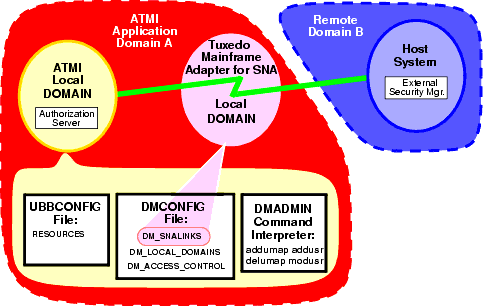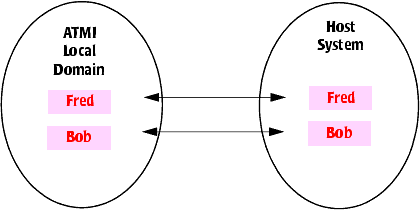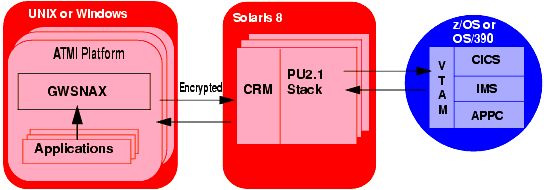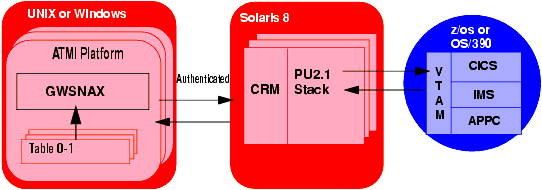User Guide
|
|
|
Get Adobe Reader |
Providing Security
Security refers to techniques for ensuring that data stored in a computer or passed between computers is not compromised. Most security measures involve passwords and data encryption. A password is a secret word or phrase that gives a user access to a particular program or system, and data encryption is the translation of data into a form that is unintelligible without a deciphering mechanism.
This section covers the following topics:
- Understanding Tuxedo Mainframe Adapter for SNA Security
- Mapping User IDs
- Using Encryption
- Using TCP/IP Link Authentication
Note: All references to ATMI files, functions, and documentation apply to Tuxedo files, functions, and documentation.
Understanding Tuxedo Mainframe Adapter for SNA Security
Distributed applications such as those used for electronic commerce (e-commerce) offer many access points for malicious people to intercept data, disrupt operations, or generate fraudulent input. The more distributed a business becomes, the more vulnerable it is to attack. Thus, the distributed computing software or middleware, upon which such applications are built must provide security.
BEA Tuxedo Mainframe Adapter for SNA works with the ATMI platform to enable the following security capabilities:
Mapping User IDs
User IDs are used to control access to system resources in the ATMI and mainframe environments. For user IDs to be used by those ATMI and mainframe environments, both sides must have security mechanisms in place. For the ATMI domain, the security mechanism is the Authorization Server. For the host system, the security mechanism is the External Security Manager. Figure 4-1 shows Tuxedo Mainframe Adapter for SNA security elements.
The Tuxedo Mainframe Adapter for SNA software allows user IDs to be shared between domains in two ways:
- ATMI-to-Host User ID Mapping
- Direct User ID Mapping
Figure 4-1 Tuxedo Mainframe Adapter for SNA Security Elements
Caution: Mixed environment security is more complex than depicted in Figure 4-1. A domain without an operational security mechanism in place accepts all transaction requests by treating user IDs as "trusted users." Refer to the appropriate ATMI product documentation for more detailed information about domain security.
ATMI-to-Host User ID Mapping
ATMI-to-host user ID mapping associates a user ID in the local domain with a corresponding user ID in the host system. With ATMI-to-host user ID mapping, an ATMI user ID can be different from its counterpart on the host. See Figure 4-2.
The dmadmin commands are used to create this kind of mapping. Refer to the "Using dmadmin Commands to Administer User ID Mapping" section. These commands change the binary form of the DMCONFIG file (called the BDMCONFIG file).
Figure 4-2 Typical ATMI-to-host User ID Mapping
Direct User ID Mapping
Direct user ID mapping enables the direct mapping of an ATMI user ID to an identical host user ID. This eliminates the need to use the dmadmin commands, as with ATMI-to-host user ID mapping. When this feature is used, any user ID mappings in the BDMCONFIG file are bypassed. To enable this feature, specify a command-line parameter with the GWSNAX command when starting the Tuxedo Mainframe Adapter for SNA Gateway. Refer to the "Bypassing User ID Mapping" section.
Note: When direct user ID mapping is used, modification or elimination of any BDMCONFIG file mapping entries is not necessary.
With direct user ID mapping, the user IDs in the ATMI and host environments must be identical as shown in Figure 4-3. When the ATMI local domain initiates a request, the ATMI user ID is applied to the requested host service. When the host initiates a request, the host user ID is applied to the requested ATMI service.
Notes: Identical user IDs must exist in the local domain and in the host domain for direct user ID mapping to be used.
With direct mapping, only security level IDENTIFY can be supported.
Figure 4-3 Direct User ID Mapping
Configuring User ID Mapping
Specify parameters bearing on local domain and Tuxedo Mainframe Adapter for SNA security in the DMCONFIG and UBBCONFIG files in the following four sections:
DM_LOCAL_DOMAINSsection of theDMCONFIGfileDM_SNALINKSsection of theDMCONFIGfileDM_ACCESS_CONTROLsection of theDMCONFIGfileRESOURCESsection of theUBBCONFIGfile
Determining Security Parameters
The combined settings of the SECURITY parameters in the UBBCONFIG and the DMCONFIG files have the following effects:
- When the
DM_LOCAL_DOMAINSsecurity parameter is set toNONEorAPP_PW, no action is taken by the Gateway with regard to security. - However, when the
UBBCONFIGfile security parameter is set toAPP_PW, the application password is validated by anAUTHSVCwhen clients join the application. TheAUTHSVCis provided by the user application.
If security is to be enforced by both the local domain and the host system for each request inbound from the host system to the local domain, the following settings must be made:
- The
UBBCONFIGfileSECURITYparameter must be set to one ofUSER_AUTH,ACL, orMANDATORY_ACL. - The
DMCONFIGfileDM_LOCAL_DOMAINSsectionSECURITYparameter must be set toDM_USER_PW. - The
DMCONFIGfileDM_SNALINKSSECURITYparameter must be set toIDENTIFY. - The SNA stack must be configured with the appropriate parameter for
IDENTIFY. - The
ATTACHSEClevel for the connection definition in the host system must be set toIDENTIFYorVERIFYto match theDMCONFIGfileDM_SNALINKSSECURITYparameter.
Determining Security Parameters for Inbound Requests
Table 4-1 shows settings for the SECURITY parameters in the UBBCONFIG and DMCONFIG files required to achieve local domain and host system security combinations for inbound requests from the host system.
Note: Security setting combinations other than those shown in the tables will have unpredictable results.
For requests sent from the host system, the local domain extracts the remote user ID, or user ID and password, from the conversation start-up request and checks the domain security table. That table contains pairs of local principal user IDs and remote user IDs, maintained on a service-by-service basis. The remote user ID is mapped to the local principal user ID. The local principal user ID and password are used for further ACL checking, as specified in the UBBCONFIG file. If the direct user ID mapping option is specified, the remote user ID is used as the local principal user ID.
When a request is received from the host system, the local domain checks the ACL in the DMCONFIG file for the local service to see if requests from the remote domain are permitted. If the DMCONFIG file does not contain an ACL for the local service, the service is accessible to all requests.
Determining Security Parameters for Outbound Requests
If security is to be enforced by both the local domain and the host system for each request outbound from the local domain, the following settings must be made:
- The
UBBCONFIGfileSECURITYparameter must be set to one ofUSER_AUTH,ACL, orMANDATORY_ACL. - The
DMCONFIGfileDM_LOCAL_DOMAINSsectionSECURITYparameter must be set toDM_USER_PW. - The
DMCONFIGfileDM_SNALINKSSECURITYparameter must be set toIDENTIFYorVERIFY. - The SNA stack must be configured with the appropriate parameter for
IDENTIFYorVERIFY. - The
ATTACHSEClevel for the connection definition in the host system must be set toIDENTIFYorVERIFYto match theDMCONFIGfileDM_SNALINKSSECURITYparameter.
Table 4-2 shows settings for the SECURITY parameters in the UBBCONFIG and DMCONFIG files required to achieve local domain and host system security combinations for outbound requests.
Note: Security setting combinations other than those shown in the tables will have unpredictable results.
For a request sent to the host system, the local principal user ID is located in the domain security table and the associated remote user ID, or user ID and password, are put into the conversation start-up request before being sent over the LU6.2 conversation. This situation occurs if SECURITY is set to IDENTIFY or VERIFY in the DM_SNALINKS section of the DMCONFIG file. If the direct user ID mapping option is specified, the local principal user ID is put into the conversation startup request.
Setting DMCONFIG File Security Parameters
Three sections in the DMCONFIG file contain parameters affecting Tuxedo Mainframe Adapter for SNA control of access to the ATMI local domain:
DM_LOCAL_DOMAINSsection contains aSECURITYparameter which specifies the type of security enforced for the ATMI local domain.DM_SNALINKSsection contains aSECURITYparameter that records the security in effect for the host system.DM_ACCESS_CONTROLsection contains local access control lists used by the ATMI local domain to associate local resources with host systems permitted to have access to them.
Caution: Do not delete the DMCONFIG binary file before running the dmloadcf command. Tables of remote users, remote passwords, and remote mappings are stored in this file. If deleted, all security information must be re-entered.
DM_LOCAL_DOMAINS Section
The SECURITY parameter settings in this section work in conjunction with the SECURITY parameter in the RESOURCES section of the ATMI local domain's UBBCONFIG file to establish how Tuxedo Mainframe Adapter for SNA controls access to the ATMI local domain. The parameter takes the form:
SECURITY = {value}
If this parameter is set to NONE or APP_PW, the local domain takes no action with regard to security. If this parameter is set to DM_USR_PW, the local domain enforces security according to the setting in the UBBCONFIG file (refer to "Setting DMCONFIG File Security Parameters").
DM_SNALINKS Section
This section of the DMCONFIG file is dedicated to Tuxedo Mainframe Adapter for SNA parameters. It records the security in effect for the host system. It correlates to the values set for the ATTACHSEC parameter in the connection resource definition. In the following parameter definition, remote refers to the ATMI domain and local refers to the host system. The parameter takes the form:
SECURITY_TYPE = {value}
In this parameter, value can be set as:
Specifies that a user identifier is not to be supplied by the remote system.
LOCALis the default value.Specifies that a user identifier is expected on every attach request. All remote users of a system must be identified to the remote external security manager.
Attaches a user ID and valid password to the remote region. The user ID and password are controlled by the region's external security manager.
The values LOCAL and IDENTIFY are roughly equivalent to NONE and APP_PW for the SECURITY parameter in the DMCONFIG file.
DM_ACCESS_CONTROL Section
This section contains local ACL used by the ATMI local domain to restrict access by remote regions to local resources. Refer to the "ATMI Security Administration" section in the BEA Tuxedo 8.0 documentation.) Each entry consists of an ACL_NAME resource identifier along with a list of required parameters designating remote domains permitted to access the resource. If no entry exists for a local service, the service is accessible to all remote domains.
Setting UBBCONFIG File Security Parameters
The RESOURCES section in this file contains a SECURITY parameter that works in conjunction with the SECURITY parameter in the DMCONFIG file to establish how Tuxedo Mainframe Adapter for SNA controls access to the ATMI local domain. This parameter takes the form:
SECURITY = {value}
In this parameter, value can be set as:
Requires password authorization for the Gateway and administrative tools to connect to the local application.
Same as
USER_AUTH, but additional access-control checks are done on service names, queue names, and event names. If no Access Control Lists (ACL) exists for a given name, access is granted.
In most cases, the UBBCONFIG file has already been configured and you do not need to establish the SECURITY parameter settings, but examining this file enables you to see how Tuxedo Mainframe Adapter for SNA enforces security.
If this parameter is set to NONE, no security is enforced. If set to APP_PW, the local ATMI domain's Authorization Server prompts for the application password. If set to USER_AUTH, ACL, or MANDATORY_ACL, the qualified security is enforced as specified.
Bypassing User ID Mapping
To use direct user ID mapping, use the -m parameter in the GWSNAX process start-up command line entry. This parameter allows you to establish direct user ID mapping, rather than ATMI-to-host user ID mapping.
Note: If you bypass user ID mapping, the local and host domains must have identical user IDs in effect, otherwise a security error occurs.
For example, to set the Gateway server process to bypass user ID mapping, enter a command in the following format:
GWSNAX SRVGRP = <groupname> SRVID = <number> CLOPT = "-A -- -m"
Refer to GWSNAX in Appendix A, "Administrative Command Reference Pages" for more information.
Using dmadmin Commands to Administer User ID Mapping
When ATMI-to-host user ID mapping is used, you must create mappings in the BDMCONFIG file.
Note: If the direct user ID mapping option is specified, creation of mappings in the BDMCONFIG file is not necessary. Any mappings in the BDMCONFIG file are ignored.
User ID mapping between the local domain and the host system is configured using the addumap, addusr, delumap, modusr, and delusr commands of the dmadmin utility to accomplish the following tasks:
- Adding a User ID and Password
- Mapping a User ID
- Removing User ID Mapping
- Deleting a User ID and Password
- Modifying a Password
Refer to Appendix A, "Administrative Command Reference Pages" for more information about each ATMI command.
To use these commands, enter dmadmin at the system prompt. At the dmadmin ">" prompt, enter the commands as described.
Adding a User ID and Password
Use the addusr ATMI command to add an ATMI local domain user ID and password to the remote domain user and password file. Enter the following command:
addusr {-d} local_domain_id {-R} remote_domain_id {-u} remote_userid [{-w}]
The arguments and options in this command are defined in the following way:
Mapping a User ID
Use the addumap ATMI command to map a local domain principal user ID number to a remote domain user name. The user ID must be added before it can be mapped. Refer to the "Adding a User ID and Password" section. Enter the following command:
addumap {-d} local_domain_id {-R} remote_domain_id
{-p} local_principal_userid {-u} remote_userid
The arguments and options in this command are defined in the following way:
Removing User ID Mapping
Use the delumap ATMI command to remove the mapping for a local domain principal user ID to a remote domain user name. Enter the following command:
delumap {-d} local_domain_id {-R} remote_domain_id
{-p} local_principal_userid {-u} remote_userid
The arguments and options in this command are defined in the following way:
Deleting a User ID and Password
Use the delusr ATMI command to remove a local ATMI domain user ID and password from the remote domain user and password file. The mapping for a user ID must be removed before the user ID can be removed. Enter the following command:
delusr {-d} local_domain_id {-R} remote_domain_id {-u} remote_userid
The arguments and options in this command are defined in the following way:
Modifying a Password
Use the modusr ATMI command to modify a local domain user's password recorded in a remote domain's user and password file. Enter the following command:
modusr {-d} local_domain_id {-R} remote_domain_id {-u} remote_userid [{-w}]
The arguments and options in this command are defined in the following way:
Setting Security Scenario
This section provides an example of step-by-step instructions for setting up security in an application that has already been configured.
Configuring Security in the ATMI Domain
- Add users to the ATMI domain by using the
tpusraddcommand. The command prompts for each password, for example: - Modify the ATMI client to specify security parameters in the
tpinitcall. Listing 4-1 is an example of the code to do this.
Note: SECURITY USER_AUTH level implies that application passwords, user IDs, and user passwords are required to join the application. AUTHSVR is the ATMI-supplied authentication server. It advertises the service AUTHSVC.
tmloadcf -y ubbconfig.sna
tpusradd me
Listing 4-1 Security Parameters Added to tpinit Call
TPINIT *tpinitbuf;
char passwd[30];
int security_level;
/* Initialize security parameters */
if ((tpinitbuf = (TPINIT *) tpalloc("TPINIT", NULL,
TPINITNEED(sizeof(passwd)))) == NULL)
{
userlog("tpalloc tpinit failed %s \n", tpstrerror(tperrno));
exit(1);
}
strcpy(tpinitbuf->usrname,"");
strcpy(tpinitbuf->cltname,"");
strcpy(tpinitbuf->passwd,"");
strcpy(tpinitbuf->grpname,"");
/* Determine level of enforced security */
security_level = tpchkauth();
if ((security_level == TPSYSAUTH) || (security_level ==
TPAPPAUTH))
{
fprintf(stdout,"\nApplication passwd required.");
fprintf(stdout,"\nApplication passwd:");
gets(tpinitbuf->passwd);
}
if (security_level == TPAPPAUTH)
{
fprintf(stdout,"\nUser Name required.");
fprintf(stdout,"\nUser Name:");
gets(tpinitbuf->usrname);
fprintf(stdout,"\nUser Password required.");
fprintf(stdout,"\nUser Password:");
gets(passwd);
strcpy(&tpinitbuf->data,passwd);
tpinitbuf->datalen=strlen(passwd);
}
if (tpinit(tpinitbuf) == -1)
{
userlog("TPINIT %s \n", tpstrerror(tperrno));
exit(1);
}
- Add the user name mapping for the remote domain by invoking
dmadminand using theaddumapcommand to map local user IDs to remote user IDs. For example: - Add a password for remote user IDs for the remote domain by invoking
dmadminand using theaddusrcommand to provide remote password(s). For example:
dmloadcf -y dmconfig.sna
tmboot -y
dmadmin
>addumap -d myldom -R myrdom -p localme -u REMOTEME
dmadmin
>addusr -d myldom -R myrdom -u REMOTEME
Configuring Security in the Local Domain
To configure security in the local domain:
Refer to the appropriate stack documentation.
Configuring Security in the Remote Domain
Change the security of connection definitions on the mainframe host by doing the following:
- Alter security of each connection definition by changing the value of
ATTACHSECtoVERIFYon each connection definition. - Put each connection out of service by inquiring on the connection's
CEMT I CONN(MYCN)and tabbing to the connection, then changing theINSentry toOUT.
CEDA EX GR(MYCONNGRP)
CEDA I GR(MYCONNGRP)
Setting the Security Level to IDENTIFY
To configure the previous example with a security level of IDENTIFY, complete the following steps:
Using Encryption
To establish secure communications between the Communication Resource Manager (CRM) and the Gateway (GWSNAX) over a distributed network, Tuxedo Mainframe Adapter for SNA uses a link-level encryption process.
Illustration of Encryption Process
As illustrated in the following diagram, this encryption feature only applies to the link between the Tuxedo Mainframe Adapter for SNA Gateway and the CRM.
Note: The appropriate ATMI security add-on (40 bit or 128 bit) must be purchased to enable encryption.
The encryptions process occurs in the following way:
- When the Gateway establishes a connection to the CRM, the entities exchange messages to determine if encryption is enabled.
Note: When encryption is established for communications between the CRM and the Gateway, system performance may deteriorate. The higher the encryption level, the more likely deterioration may occur.
Configuring the Tuxedo Mainframe Adapter for SNA Gateway and CRM for Encryption
To configure the Tuxedo Mainframe Adapter for SNA Gateway:
See
GWSNAXin Appendix A, "Administrative Command Reference Pages."
- If the CRM is started from the command line, add the -n option with the desired
minandmax, as described inSNACRMin Appendix A, "Administrative Command Reference Pages." - If the CRM is started as an ATMI server, modify the
SNACRMserver entry to contain the -noption with the desiredminandmax, as described inSNACRMin Appendix A, "Administrative Command Reference Pages."
If crmlkoff, crmlkon, or crmdown are used with encrypted CRM, no additional command line arguments are needed.
Using TCP/IP Link Authentication
In addition to encryption, Tuxedo Mainframe Adapter for SNA uses an authentication process to establish secure communications between the CRM and Gateway over a distributed network.
Table 4-3 lists the processes that support authentication.
Illustration of Authentication Process
As illustrated in the following diagram, this authentication feature only applies to the link between the Gateway and the CRM.
Figure 4-5 Authenticated Links
When the Gateway establishes a connection to the CRM, the following events occur:
Configuring the Tuxedo Mainframe Adapter for SNA Gateway and CRM for Authentication
To configure the Gateway for authentication, complete the following steps:
- Create a text file containing the authentication key. This key should be no more than eight characters. Communicating processes must have the same entry in their key files for authentication to be successful.
- Store the
keyfilein a protected location. - Use a general command line entry with the following format to establish authentication, as described in
GWSNAXin Appendix A, "Administrative Command Reference Pages":
[-u <keyfile>]
- Create a text file containing the authentication key. This key should be no more than eight characters. Communicating processes must have the same entry in their key files for authentication to be successful.
- Store the
keyfilein a protected location. - If the CRM is started from the command line, add the
-u<keyfile>option, as described inSNACRMin Appendix A, "Administrative Command Reference Pages." - If the CRM is started as an ATMI server, modify the
SNACRMserver entry to contain the-u<keyfile>option as described inSNACRMin Appendix A, "Administrative Command Reference Pages." - If
crmlkoff,crmlkon, orcrmdownare used with a CRM with authentication enabled, use the-u<keyfile>command line option as described inSNACRMin Appendix A, "Administrative Command Reference Pages."
Using Third-Party Security Software
The Tuxedo security plug-in allows users to customize security functions and use alternate implementations of third-party security software. The Tuxedo security plug-in is set up during Tuxedo plug-in configuration. Refer to the Tuxedo documentation for specific information about this feature.




